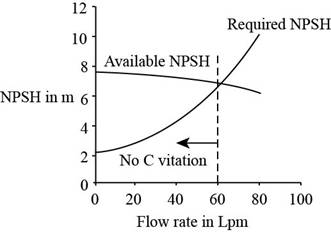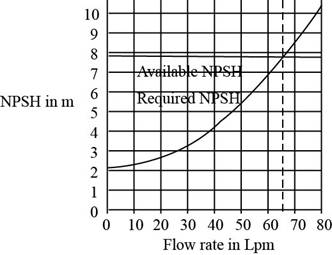
Concept explainers
Repeat Prob. 14-60, but with the pipe diameter increased by a factor of 2 (all else being equal). Does the volume flow rate at which cavitation occurs in the pump increase or decrease with the larger pipe? Discuss.
Whether the volume flow rate at which cavitations occurs in the pump increase or decrease of the larger pipe.
Answer to Problem 62P
The diameter of the pipe is doubled then the flow rate increase by
Explanation of Solution
Given information:
The pipe diameter is increased by the factor two.
Write the expression for the net positive suction head.
Here, the net positive suction head is
Write the expression for the total head loss.
Here, the friction factor is
Write the expression for the average speed.
Here, the diameter of the pipe is
Write the expression for the Reynolds number.
Here, the Reynolds number is
Write the expression for the friction factor.
Substitute
Write the expression for the required net positive suction head.
Here, the required net positive head is
Write the expression for the percentage increase.
Here, the percentage increase is
Calculation:
Refer the Table B-1, "The physical properties of saturated liquid" to obtain the value of the density is
Refer the Table B-1, "The physical properties of saturated liquid" to obtain the value of the kinematic viscosity is
Refer the Table B-1, "The physical properties of saturated liquid" to obtain the value of the vapor pressure is
Substitute
Substitute
Substitute
Substitute
Substitute
Substitute
The following table represents the net positive suction head, the required net positive suction head, and discharge.
| | |
Plot the graph by using tabulated values.

Figure-(1)
From Figure-(1), the cavitations occurs at the flow rate
Substitute
Substitute
Substitute
Substitute
Substitute
Substitute
The following table represents the net positive suction head, the required net positive suction head, and discharge.
| | |
Plot the graph by using tabulated values.

Figure-(2)
From Figure-(2), the cavitations occurs at the flow rate
Substitute
The diameter of the pipe is doubled then the flow rate increase by
Conclusion:
The diameter of the pipe is doubled then the flow rate increase by
Want to see more full solutions like this?
Chapter 14 Solutions
FLUID MECHANICS FUNDAMENTALS+APPS
- Two squirrels are sitting on the rope as shown. The squirrel at A has a weight of 1.2 lb. The squirrel at B found less food this season and has a weight of 0.8 lb. The angles 0 and > are equal to 50° and 60° respectively. Determine the tension force in each of the rope segments (T₁ in segment, T₂ in segment Я, and T3 in segment DD) as well as the angle a in degrees. Ө A α B Note the figure may not be to scale. T₁ = lb lb T2 T3 = = lb απ deg A BY NC SA 2013 Michael Swanbomarrow_forwardEach cord can sustain a maximum tension of 500 N. Determine the largest mass of pipe that can be supported. B 60° A E Harrow_forward2. Link BD consists of a single bar 1 in. wide and 0.5 in. thick. Knowing that each pin has a in. diameter, determine (a) the maximum value of the normal stress in link BD and the bearing stress in link BD if 0 = 0, (b) the maximum value of the normal stress in link BD if 0 = 90. -6 in.- 12 in. 30° D 4 kipsarrow_forward
- In the image is a right rectangular pyramid of total mass m. Note the location of point Q. Determine the inertia dyadic for the pyramid P, relative to point Q for e hat unit vectors.arrow_forwardauto controlsarrow_forwardI am having a hard time solving for the vector v in the equation in the image. Can you help me?arrow_forward
- A 4 ft 300 Ib 1000 Ib.ft 350 Ib C 2 ft 3. 45° 250 Ib B. 3ft B 25ft 200 Ib 150 Ib Replace the force system acting on the frame shown in the figure by a resultant force (magnitude and direction), and specify where its line of action intersects member (AB), measured from point (A).arrow_forwardCan you research the standard percentage of Steam Quality in:(1.) Boiler - leaving boilerBoiler -> Out(2.) Condenser - coming in condenser In -> CondenserProvide reference Also define: steam quality, its purpose and importancearrow_forwardNumbers 1 and 2 and 5 are are optional problems. However, I only need the values (with units) of 3, 4 and 6. Thank you :)arrow_forward
 Elements Of ElectromagneticsMechanical EngineeringISBN:9780190698614Author:Sadiku, Matthew N. O.Publisher:Oxford University Press
Elements Of ElectromagneticsMechanical EngineeringISBN:9780190698614Author:Sadiku, Matthew N. O.Publisher:Oxford University Press Mechanics of Materials (10th Edition)Mechanical EngineeringISBN:9780134319650Author:Russell C. HibbelerPublisher:PEARSON
Mechanics of Materials (10th Edition)Mechanical EngineeringISBN:9780134319650Author:Russell C. HibbelerPublisher:PEARSON Thermodynamics: An Engineering ApproachMechanical EngineeringISBN:9781259822674Author:Yunus A. Cengel Dr., Michael A. BolesPublisher:McGraw-Hill Education
Thermodynamics: An Engineering ApproachMechanical EngineeringISBN:9781259822674Author:Yunus A. Cengel Dr., Michael A. BolesPublisher:McGraw-Hill Education Control Systems EngineeringMechanical EngineeringISBN:9781118170519Author:Norman S. NisePublisher:WILEY
Control Systems EngineeringMechanical EngineeringISBN:9781118170519Author:Norman S. NisePublisher:WILEY Mechanics of Materials (MindTap Course List)Mechanical EngineeringISBN:9781337093347Author:Barry J. Goodno, James M. GerePublisher:Cengage Learning
Mechanics of Materials (MindTap Course List)Mechanical EngineeringISBN:9781337093347Author:Barry J. Goodno, James M. GerePublisher:Cengage Learning Engineering Mechanics: StaticsMechanical EngineeringISBN:9781118807330Author:James L. Meriam, L. G. Kraige, J. N. BoltonPublisher:WILEY
Engineering Mechanics: StaticsMechanical EngineeringISBN:9781118807330Author:James L. Meriam, L. G. Kraige, J. N. BoltonPublisher:WILEY





